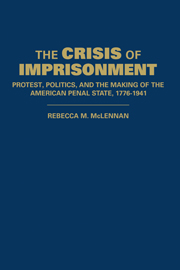Book contents
- Frontmatter
- Contents
- Acknowledgments
- Introduction: The Grounds of Legal Punishment
- 1 Strains of Servitude: Legal Punishment in the Early Republic
- 2 Due Convictions: Contractual Penal Servitude and Its Discontents, 1818–1865
- 3 Commerce upon the Throne: The Business of Imprisonment in Gilded Age America
- 4 Disciplining the State, Civilizing the Market: The Campaign to Abolish Contract Prison Labor
- 5 A Model Servitude: Prison Reform in the Early Progressive Era
- 6 Uses of the State: The Dialectics of Penal Reform in Early Progressive New York
- 7 American Bastille: Sing Sing and the Political Crisis of Imprisonment
- 8 Changing the Subject: The Metamorphosis of Prison Reform in the High Progressive Era
- 9 Laboratory of Social Justice: The New Penologists at Sing Sing, 1915–1917
- 10 Punishment without Labor: Toward the Modern Penal State
- Conclusion: On the Crises of Imprisonment
- Select Bibliography
- Index
Conclusion: On the Crises of Imprisonment
Published online by Cambridge University Press: 18 August 2009
- Frontmatter
- Contents
- Acknowledgments
- Introduction: The Grounds of Legal Punishment
- 1 Strains of Servitude: Legal Punishment in the Early Republic
- 2 Due Convictions: Contractual Penal Servitude and Its Discontents, 1818–1865
- 3 Commerce upon the Throne: The Business of Imprisonment in Gilded Age America
- 4 Disciplining the State, Civilizing the Market: The Campaign to Abolish Contract Prison Labor
- 5 A Model Servitude: Prison Reform in the Early Progressive Era
- 6 Uses of the State: The Dialectics of Penal Reform in Early Progressive New York
- 7 American Bastille: Sing Sing and the Political Crisis of Imprisonment
- 8 Changing the Subject: The Metamorphosis of Prison Reform in the High Progressive Era
- 9 Laboratory of Social Justice: The New Penologists at Sing Sing, 1915–1917
- 10 Punishment without Labor: Toward the Modern Penal State
- Conclusion: On the Crises of Imprisonment
- Select Bibliography
- Index
Summary
The foregoing pages relate the story of the great crisis of legitimacy that struck the American system of legal punishment in the Gilded Age and flesh out an account of the diverse, and often contradictory, reform efforts that this crisis precipitated. As we have seen, America's prison-based system of legal punishment, with which the early Republicans first tentatively experimented, and which the Jacksonians subsequently transformed and institutionalized (in the form of contractual penal servitude), was episodically shaken to its foundations by acute disciplinary, political, and ideological crises. At all times anchored in overlapping fields of power (the plane on which contractors encountered prison keepers and convict laborers, for example, and the fraught arena in which free workingmen grappled with employers and responded to the often violent, dislocating effects of industrialization), the prison proved both a site and an instrument in an ongoing negotiation between distinct segments of American society over the profound moral and political questions thrown up by the rise of industrial capitalism. Although only intermittently aflame in riot and rebellion or under siege from an outraged citizenry, the American prison existed (and arguably, still exists) in a permanent state of crisis. Rather than interpret the various crises of imprisonment as so many signs of the failure or defeat of well-intended penal reformers, I have tried to convey the ways in which the penal system's emergencies were at once destructive and creative.
- Type
- Chapter
- Information
- The Crisis of ImprisonmentProtest, Politics, and the Making of the American Penal State, 1776–1941, pp. 469 - 472Publisher: Cambridge University PressPrint publication year: 2008



